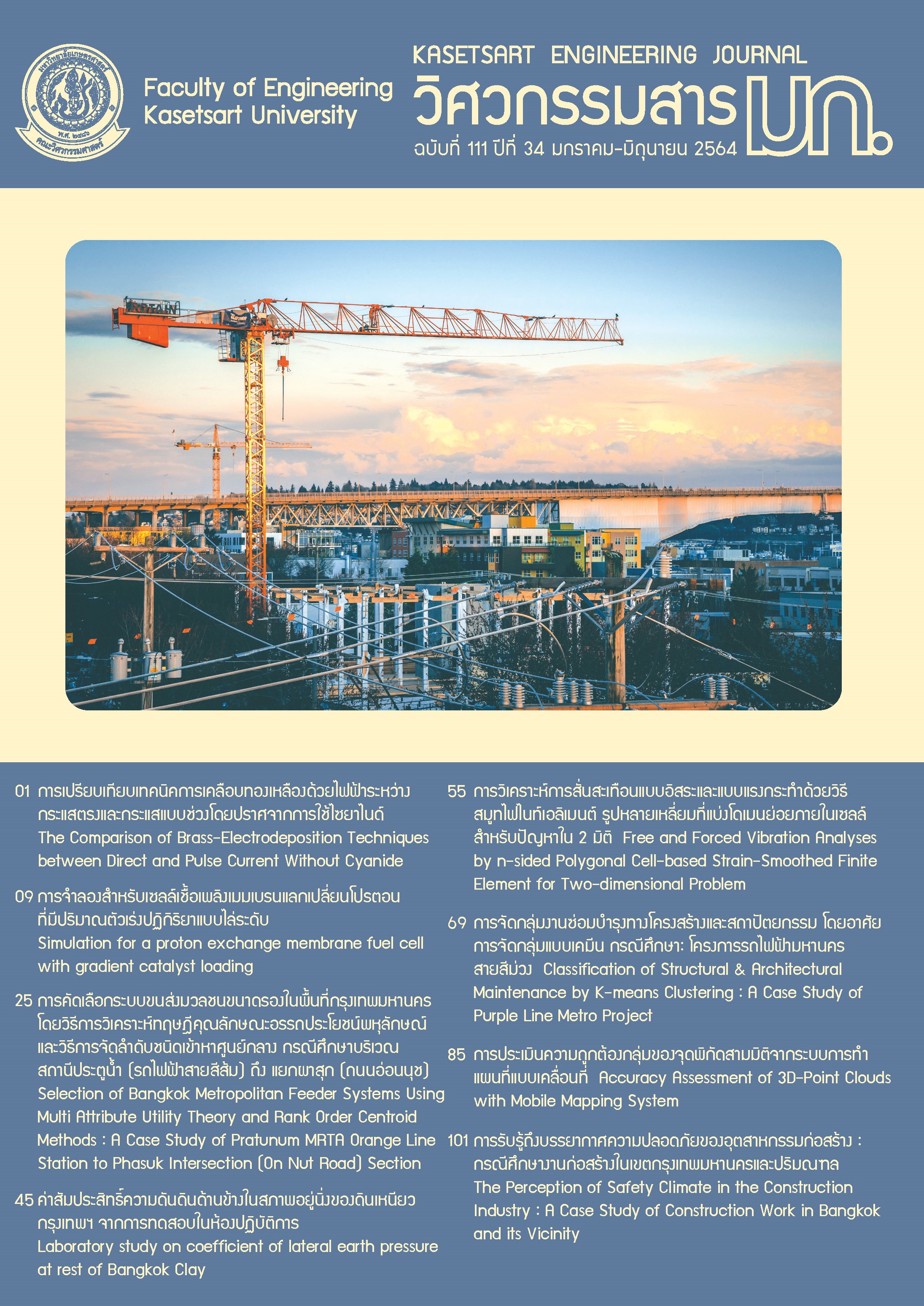The Comparison of Brass-Electrodeposition Techniques between Direct and Pulse Current Without Cyanide
Keywords:
Electroplating, Cyanide, Brass, Pulse Current, Corrosion resistanceAbstract
Generally, the electrodeposition of Cu-Zn alloy or brass coating mostly uses a cyanide electrolyte in the manufacturing process. As the coating surface of the product is good quality by cyanide solution, it has led to being popular in the industries. The cyanide-containing electrolyte solution is not only dangerous to human health and the environment but also includes the cost increasing from machine maintenance. It stems from the cyanide toxicity. Therefore, this work aims to study the brass-electrodeposition technique with the cyanide-free solution. The comparison between direct current (DC) and pulse current (PC) is investigated in the plating process that the duty cycle of PC is determined as 33%, 50% and 67% respectively. The results of studies and comparisons of electrodeposition technique pulse current at 33% of duty cycle resulted in the smallest coating layer grain size. The hardness of the coating layer is the highest. It also results in the highest corrosion resistance of the coating layer.
References
Oulmas C et al. (2019). Comparative study of Cu–Zn coatings electrodeposited from sulphate and chloride baths. Heliyon, 5(7): p.e02058.
Ibrahim M, E Ismail, and R Bakdash (2019). Copper-rich copper–zinc alloy coatings prepared by electrodeposition from glutamate complex electrolyte: current efficiency, Tafel kinetics and throwing power. Transactions of the IMF, 97:237-246.
Fujiwara Y, and H Enomoto (2000). Electrodeposition of βʹ-Brass from Cyanide Baths with Accumulative Underpotential Deposition of Zn. Journal of The Electrochemical Society, 147(5): 1840.
Senna L F, S L Díaz, and L Sathler (2003). Electrodeposition of copper–zinc alloys in pyrophosphate-based electrolytes. Journal of Applied Electrochemistry, 33: 1155-1161.
Luque-Almagro V M et al. (2011). Bacterial cyanide degradation is under review: Pseudomonas pseudoalcaligenes CECT5344, a case of an alkaliphilic cyanotroph. Biochemical Society transactions, 39(1): 269-74.
Sharma M, Y Akhter, and S Chatterjee (2019). A review on remediation of cyanide containing industrial wastes using biological systems with special reference to enzymatic degradation. World Journal of Microbiology and Biotechnology, 35(5): 70.
Yi C, and S Majid (2018). The Electrochemical Performance of Deposited Manganese Oxide-Based Film as Electrode Material for Electrochemical Capacitor Application.
มะลิ แซ่อึ้ง (2544). การศึกษาปัจจัยที่มีผลต่อความหนาของผิวเคลือบ ในกระบวนการเคลือบผิวไฟฟ้า. จุฬาลงกรณ์มหาวิทยาลัย.
Kamnerdkhag P et al. (2017). The effects of duty cycles on pulsed current electrodeposition of Zn Ni Al 2 O 3 composite on steel substrate: Microstructures, hardness and corrosion resistance. International Journal of Hydrogen Energy, 42.
รุจีภรณ์ นาคขุนทด (2560). การประเมินผลพฤติกรรมการกัดกร่อนของโลหะจากเส้นโค้งโพลาไรเซชัน (polarization curve) – KM Tank.
Krishnan R M, V S Muralidharan, and S R Natarajan (1996). A non-cyanide brass plating bath. Bulletin of Electrochemistry, 12(5-6): 274-277.
Kartal M, A Alp, and H Akbulut (2017). Pulse Electrodeposition of Copper-Zinc Coatings from an Alkaline Bath. Acta Physica Polonica A, 132: 801-803.
Downloads
Published
Issue
Section
License

This work is licensed under a Creative Commons Attribution-NonCommercial-NoDerivatives 4.0 International License.


